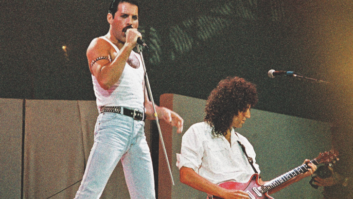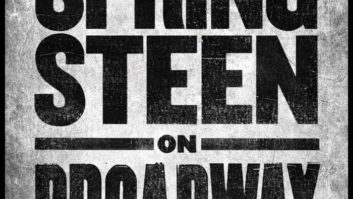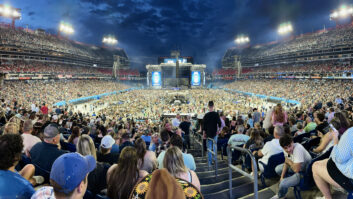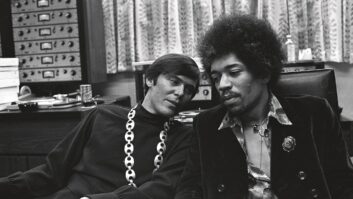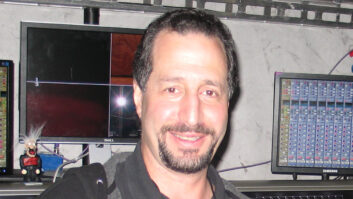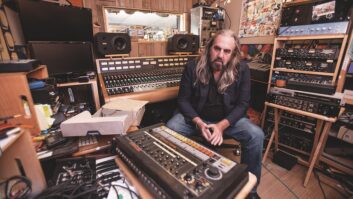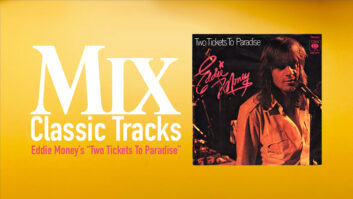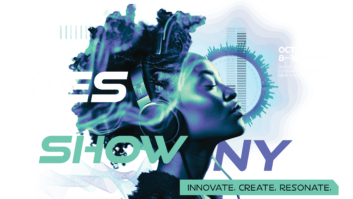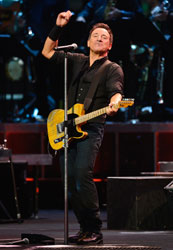
Photo: Steve Jennings
Front-of-house engineers often tell us that their top priority is to make sure the audience can hear all of the lyrics, especially when the lead singer is a great storyteller, a singer/songwriter type. All over club land, mixers strive to create a balanced mix, but keep those vocals intelligible and out-front. However, that task gets a bit more challenging when the singer/songwriter is fronting a powerhouse 16-piece band, and the audience is giving the 180-cabinet L-Acoustics P.A. a run for its money—shouting, singing along, bellowing “Broooooce” between numbers, and effectively defining the term “thunderous applause.” Bruce Springsteen’s eight-man audio crew has the job of delivering meaningful, dynamic sound to packed arenas full of those joyful fans—and to a fairly packed stage as well—and their hard work helps Springsteen and his E Street Band maintain a start-to-finish fever pitch for more than three hours, the way The Boss intended it.
“I’m working for a guy who has such a clear vision of where his music needs to go and how it needs to get there,” says Springsteen’s longtime FOH engineer John Cooper. “We had a conversation onstage 10 years ago in our first couple of rehearsals and it became very clear what I had to do to deliver this show, and that was to take it to a level where I got on top of the stage volume and on top of the audience. Nothing less does the material justice.
“I think the show does breathe dynamically pretty well,” continues Cooper, who has also mixed dates with Sheryl Crow, Ringo Starr and Lionel Richie just in the past year. “But at the same time, it’s a take-no-prisoners kind of thing. It’s a real challenge at the levels we’re working at to make things discernible and let you find all the parts that are essential to a piece of music.”
Cooper’s approach requires making informed decisions on the spot. “It’s a physical impossibility to hear everything all the time,” he says. “You have to take advantage of moments that lend themselves to allowing you to deliver the song the way it was meant to be. And those parts that exist in one piece of music might not be as evident in the next piece. Sometimes it’s all about the three blazing guitars, and sometimes it’s all about the dynamic punch of the horns, or the vocal accents, or the spark of Roy [Bittan]’s signature piano sound.”
And sometimes all of those moments happen in one song. Take the classic “Badlands,” for example, which, at the show Mix caught at San Jose’s HP Pavilion, was number three in a 26-song setlist that included several tracks from the stellar new Wrecking Ball album, as well as many fan favorites and a terrific Apollo Theater-inspired interlude of soul songs. At various moments, the gigantic wall of sound gives way to reveal those lovely piano parts, or a blistering guitar solo (or two), the lyrics of an especially powerful verse, or for the first time that night, a familiar, heart-wrenching sax solo by the late Clarence Clemons’ nephew, Jake Clemons.
“With 17 people onstage, it is real estate management in the tonal spectrum,” Cooper says. “All told, you’ve got three electric guitars, two acoustic guitars, a violin at times, a horn section, two keyboard players, singers, drums… With this many inputs, dynamics control is also crucial, and the compressors and downward expanders lend an extra hand to keep things under control.”

E Street Band members (L to R) Nils Lofgren, Jake Clemons, Bruce Springsteen, Steve Van Zandt, Max Weinberg, Garry Tallent and Roy Bittan.
Photo: Steve Jennings
Supporting this carefully orchestrated, ecstatic production is Solotech, the sound company that acquired Springsteen’s longtime provider Audio Analysts last spring. Thirteen trucks and five buses carry the gear, the band, and crew from town to town. For the 70-person crew (including the audio system team, backline techs, lighting crew, etc.), each show day begins with an early load-in. By 6:30 or 7 a.m., Cooper says, “System engineer Etienne Lapré and system engineer/crew chief John Bruey are in there double-checking measurements and fine-tuning the array calculations for the P.A. for that particular venue. Then the equipment comes in over the course of the next two or three hours; all three consoles—FOH, monitor stage left and monitor stage right—are set up on rolling risers at the back of the arena. Lights go up, sound goes up, stage pushes into place, thrust goes onto the stage, and the mix position goes into place.”
Cooper’s console is an Avid Profile. He can also access redundant FOH engines through an APB MixSwitch, and he’s running primary and safety Pro Tools|HD4 systems. “There’s two of everything on this tour,” Cooper says. “For every guitar Bruce ever has in his hand, there’s an identical one that guitar tech Kevin Buell has set up in case that one has an issue. It’s very important to have escape routes and backup systems, because it’s not a question I ever want to have to address with Bruce after a show: ‘What happened?’”
By the time all of the bandmembers come in, around 5 p.m., all of the backline gear is in place, and Cooper has certain tried-and-true specs. Springsteen’s vocal chain, for example, is a Shure SM58 RF with added Waves Renaissance EQ, C6 compression and MaxxVolume dynamic processing; his guitar amps take Sennheiser 409s with Renaissance Axx compression and Crestron VEQ4.

Front row: FOH engineer John Cooper (left) and L-Acoustics K1 system engineer Etienne Lapré; back row: system engineer Klaus Bolander (left) and system engineer/crew chief John Bruey.
Photo: Steve Jennings
However, Cooper says that the time they all still call “soundcheck” is really an opportunity for the band to polish up additional tunes. Cooper does his system tuning via the Profile’s Virtual Soundcheck. “I don’t need anybody sitting there and hitting a tom for five minutes,” he says. “It gives the band the freedom to work on new material or bring an older song out of retirement. We get a setlist 10 minutes prior to a performance, but even that is very dynamic. Bruce will turn a setlist sideways in a second if he feels a show is not moving in the right direction.”
At press time, Cooper said the band had already performed more than 100 different songs on this tour, but they’d only played 17 dates.

Stage-left monitor engineer Monty Carlo (left) and stage-right monitor engineer Troy Milner.
Photo: Steve Jennings
MONITORS, LEFT AND RIGHT
Mixing monitors for 17 musicians is an unwieldy job, so the Springsteen production splits those duties in two. At stage left, engineer Monty Carlo, who’s been with Springsteen since ’92, handles the mix for Bruce, guitarists/vocalists Steven Van Zandt and Patti Scialfa (who was absent from the show we saw), keyboardist Roy Bittan, a varying number of background vocalists, and the five-piece horn section.
Stage-right monitor mixer Troy Milner—with Springsteen’s crew since 2001—takes care of drummer Max Weinberg, guitarist/singer Nils Lofgren, bass player Garry Talent, keyboardist Charlie Giordano and vocalist/multi-instrumentalist Soozie Tyrell.
Both Milner and Carlo mix on DiGiCo SD7 consoles with the Waves SoundGrid. “We went with the SD7 this tour to handle the large number of inputs and outputs,” Milner says. “I think I’m up to around 138 inputs on the desk now, which I know is crazy, but with 17 people onstage and numerous reverbs, effects and talkback mics, it adds up quick. This console gives us plenty of options to change or move things around.”
Carlo agrees, especially given the vast amount of material that this tour racks up night to night: “The ability to save each song as a preset is a huge time-saver, even if it’s as simple as muting and unmuting inputs from song to song,” he says.
Wedge monitors are a combination of proprietary Audio Analysts models powered by Crown iTech-HD 12000 amps. Milner’s musicians use Shure PSM1000 in-ears, while Carlo’s are on Sennheiser SR2050s; both engineers say that these latest-model ear transmitters help streamline their search for bandwidth. “They make our lives easier in terms of the ability to find clean frequencies, with 70 channels of wireless instruments and in-ear monitors,” Carlo says. “I’m about a week away from implementing the Axient RF system from Shure to give us an even better tool to keep our show running smoothly.”
Each musician requires his or her own mix, but one essential quality of every mix is to help the musicians keep a handle on Springsteen’s performance.

Bruce Springsteen and Steve Van Zandt
Photo: Steve Jennings
For example, “The wedge mixes for Nils Lofgren and Soozie have a lot of drums for time, but also a large amount of Bruce and his guitar, so they can follow him,” Milner explains. “You never know what he will do next.”
At the San Jose show, Springsteen not only walked the catwalk and the floor to get closer to fans, and brought a couple of kids onstage to sing or dance with him, but he also played that “trust me” game, falling backward into the crowd and back-surfing from the middle of the floor to the thrust. Plus he takes requests when it seems right.
“In Newark, somebody was holding up a sign all through the show,” Cooper says, “and Bruce said, ‘Man, I’ve got to play this song. This guy’s arm’s gonna fall off.’ So they played ‘The Weight,’ as one of their encore songs and dedicated it to Levon Helm. There wasn’t a dry eye in the building. He’s remarkable. All music matters, of course, but I feel very fortunate to be mixing music that resonates with me, too, and with so many people.”
Bruce Springsteen Audio Crew
Front-of-house engineer: John Cooper
Stage-left monitor engineer: Monty Carlo
Stage-right monitor engineer: Troy Milner
L-Acoustics K1 system engineer: Etienne Lapré
System engineer Klaus Bolender
System engineer/crew chief: John Bruey
System techs: Ray Tittle, Rob Zuchowski
